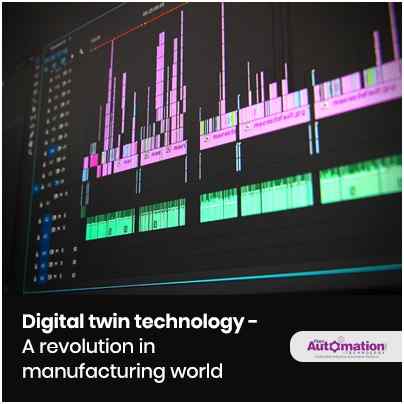Articles
Digital twin technology- A revolution in manufacturing world

Digital twin technology was one among the top 10 strategic technology trends which was named by Gartner Inc for the year 2017.

The latest market report on ''Digital twin market by technology, type, Industry, and Geography - Global Forecast to 2025", suggests that, the digital twin technology market is estimated to grow from USD 3.8 billion in 2019 to USD 35.8 billion by 2025, at a CAGR of 37.8%. North America exhibited the largest share of digital twin technology market in the year 2018, and APAC is likely to come up with highest CAGR during forecast period.
The major elements which has increased the demand for the adoption of digital twin technology manufacturing systems include declining time and cost of product development, and unplanned downtime with the adoption of digital twins, increased adoption of technologies such as IoT and cloud network. The digital twin technology manufacturing supports technologies related to Industry 4.0. This can actually given the scope to improve upon the benefit predictive maintenance, reduce waste, reduce batch changeover times, and improve product quality. Not only this, the products manufactured within this framework, starting from its designing phase to the deployment phase has digital foot print on it.
Post manufacture of the products, with digital foot print represents the 'connected digital things' generate real time data. These data helps a manufacturer to analyze problems by early warnings which is depicted through the analysis. This not only prevents the downtime, but also helps the manufacturers to develop opportunities, and plan better products in times to come, at cost effective prices by the use of simulations.
Impact of digital twin technology on business world
Digital twin technology calls for a better connectivity between the machine and the human world. For example, if you are the manufacturer and you are not at your unit. With the help of digital twin IoT and technology, you can monitor the functioning remotely through its digital counterpart. With the passage of time, as and when the role of digital twin technology grows within an industrial structure, the manufacturers may be motivated to establish digital twin for each of its customer and each of the products manufactured within their unit, based on their demand. This will not only save time, but would also give a fair idea to the manufacturers about their upcoming task, in their respective production unit, at cost effective prices.
Not only this, the digital twin IoT also enables the users develop new products based on the behavior of the existing products in the real world. Performance of the product and customer usage is reflected in the twin technology. This is further processed into the system for future production and its future manufacture.
|
Also Read: Digital Twins: A Game-Changer for Plant Design and Maintenance |
Scope of digital twin technology
The manufacturers in North America are the leaders in the usage of digital twin IoT in aerospace and automotive industries. This in turn has developed the economies of the regions in and aroudn of North America.
Since digital twin technology manufacturing systems calls for 3D printing technology in manufacturing industry, it is the Automotive and transportation sector which is all set to account for the largest size of digital twin market from 2019 to 2025.
Growth in digital twin IoT (Internet of Things), cloud based and 3D printing technology have platforms for engineers to test and communicate with sensors integrated with the operating products, hence delivering real time data with functioning statistics. It is to be noted that, in the United States of America, approximately 35 % of the manufacturers are dependent for the collection and use of data from smart sensors, to enhance the manufacturing processes.
Over the last few years, digital twin technology has found its way into industries such as energy and power, aerospace, oil and gas offering advanced testing and measurement solution on real time basis.
With the growing trend of digital twin IoT and cloud deployment platform, the industrial use of digital twin technology manufacturing systems is expected to grow at healthy rate in years to come.





